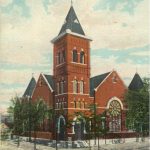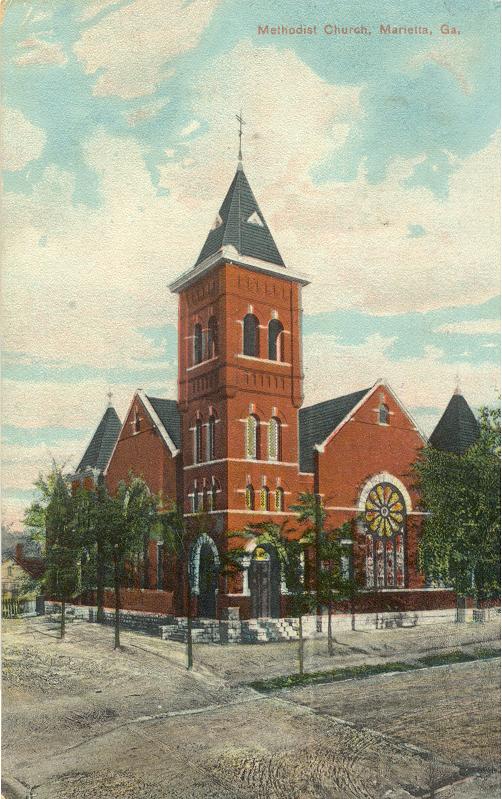 by Scott Aaron
by Scott Aaron
and the editors of LeoFrank.info
GEORGIA, as a part of the South, is a place where, though freethinkers are certainly not unknown, the vast majority of the population is deeply committed to Christianity — largely Protestant, fundamentalist Christianity. One’s personal “walk with Jesus” is taken very seriously here, and the religion informs almost every aspect of private, family, and public life. The fundamentalist worldview is dominant, as it is throughout the South, which, along with a few border states, is not called the “Bible Belt” for nothing. This was doubly true in 1913.

One of the core beliefs of fundamentalism is literalism, a belief that every word of the scriptures was directly inspired by God and is literally true. The position of the average Georgian on the Bible is expressed in the saying, common in the South, “God said it. I believe it. That settles it.” The history in the Bible is, therefore, accurate, including God’s special preference for the Jews as His people, an especially holy people. The prophetic visions of the Bible are, therefore, infallible, including the centrality of Israel and its people to God’s plan for heaven and earth. The law set down in scripture is, therefore, to be obeyed absolutely, including its commands to honor and bless God’s Chosen. The Old Testament — the entirety of which is by, about, and for Jews — is not glossed over or minimized by fundamentalists, as it is by some Christian denominations. It is God’s word; it is absolute truth no less than the New Testament. And Jehovah, the Jewish God of the Old Testament, is to fundamentalists the one and only God.

Most important of all to fundamentalist Christians, Jesus was born a Jew, spoke in the synagogues, and was in fact the prophesied Jewish Messiah. The Jewish faith, the Jewish prophets, and the Jewish people themselves were the sources from which Christ came and without which Christ could never have existed.
It is the South that is the center of Christian Zionism. Many a sermon and many a ministry in the South have as their basis Genesis 12:3, in which God says of the Jews: “I will bless them that bless thee, and curse him that curseth thee.”
In 1909, four years before Mary Phagan’s murder, the first edition of the Scofield Reference Bible was published by Cyrus Scofield. It was innovative in that explanations of, and details about, the Biblical texts were printed in a column alongside the actual verses. Scofield’s Bible was tremendously popular and influential in fundamentalist circles and remains so to this day. Scofield wrote in his note to Genesis 12:3:
It has invariably fared ill with the people who have persecuted the Jew – well with those who have protected him. The future will still more remarkably prove this principle.
In subsequent editions Scofield’s followers expanded the note, adding “For a nation to commit the sin of anti-Semitism brings inevitable judgment.”

Harry Golden reported in the American Jewish Committee’s magazine Commentary that, shortly after the establishment of the Jewish state, “Bonds for Israel” salesmen in the South would purposely seek out Christians, since they were almost all enthusiastically pro-Zionist. If asked about their reasons for supporting Zionism, a typical fundamentalist Christian response was “It’s in the book!” — meaning, of course, the Bible. Such was the dominant Southern Christian position, and this attitude toward Jews cannot have materialized suddenly in 1948, nor even in the one generation or so from Leo Frank’s trial to that date. If anything, Christian-Jewish relations were better at the inception of the Frank case than afterward, as the case left scars that are yet to be fully healed.

Those who posit a pervasive anti-Semitism in Georgia a century ago can point to a few obscure pamphlets and some of Tom Watson’s populist diatribes (though Watson himself disclaimed anti-Semitism and a few years later attacked Henry Ford for his racial condemnation of Jews). But it seems quite unlikely that any major Southern publication could match the New York Tribune editorial of 1882, which stated of Jews, “There must be some other cause than their religion which makes these people dreaded as permanent inhabitants by every country to which they come.” One is entitled to doubt that any distinguished Southern journal would have dared to reprint the Boston Saturday Evening Gazette editorial of 1879 which remarked about Jews that “It is strange that a nation which boasts so many good traits should be so obnoxious.” Additionally, as far as is known, Atlanta never had the “honor” of having a branch of the “American Anti-Semitic Association” within its borders, as Brooklyn, New York did in 1896.

In the 1890s, it was not in Marietta, Georgia, but in Saratoga Springs, New York where hoteliers famously posted signs reading “No Jews or Dogs Admitted Here.” In that crucible of Southern identity, the Civil War, Southerners made a Jew their Secretary of the Treasury in the person of Judah P. Benjamin, while the North in the person of Ulysses S. Grant physically expelled all Jews from all areas under his control, which included large parts of Kentucky, Mississippi, and Tennessee, cruelly demanding in a time of war and in an age of slow transportation that they be gone from this huge territory “within 24 hours.”
After the prolonged political battle of many New York Jews against Tammany Hall in New York City, in 1901 the city’s corrupt police force retaliated by attacking a Jewish funeral procession, billy clubs flailing. Nothing even remotely similar has been reported about the Atlanta of that era; in fact, knowing what we know about Southern-Jewish relations, it seems utterly inconceivable.

John Higham, in his “Social Discrmination Against Jews 1830 – 1930,” a work commissioned by the American Jewish Committee, called the South “historically the section least inclined to ostracize Jews,” and drew attention to the “striking Southern situation” of almost no discrimination against Jews there. True, Jewish-Gentile relations had somewhat declined there by the mid-twentieth century, and the massive campaign during the Frank appeals to paint his prosecution, and the South generally, as anti-Semitic — and the eventual creation of the Anti-Defamation League in the wake of Frank’s death — played their part in this change. The revived 20th-century Ku Klux Klan, inspired in part by the otherwise invisible and perhaps even nonexistent group that took responsibility for Leo Frank’s lynching, the Knights of Mary Phagan, was quite different from the original Klan: It took an overt and aggressive anti-Jewish position.
But the aftermath of the Frank trial had no part, of course, in the attitudes of the people of Atlanta on the day Mary Phagan was murdered. All things considered, the South in general and Atlanta in particular seem to have been, if anything, safe havens for Jews where they might escape from the anti-Semitism that was rampant around the beginning of the last century.
* * *

ATLANTA was not without real prejudices, though. The transformation of the South from an agrarian economy into an industrial one, with all its attendant evils, such as child labor, was the cause of passionate outcries for reform. The businessman, especially the industrialist, was not always looked upon with favor.
With industrialization came Northerners – often rich Northerners – who were commonly perceived as lording it over poor Southerners from illustrious family lines who, it was widely thought, ought to have been their social superiors. And the scars of the Civil War still ran deep. The war, and the sometimes brutal “Reconstruction,” was still within the living memory of the older generation. Many Atlantans of 1913 had personally experienced the killing of loved ones, defeat, exploitation, rape, poverty, hunger, dispossession, disenfranchisement, military dictatorship, and worse. The city itself had even been deliberately set afire by Union forces during the war. Though young Georgians had not experienced such horrors, they all had parents or other loved ones who had.

Southerners in 1861 had enough sense of peoplehood to separate themselves from the Union. The humiliating defeat of 1865 and the decade-long federal occupation had made that sense of peoplehood – of being a people apart, an oppressed nation within a nation – even stronger. And it bred a sense of distrust of authority, of resistance to established power, of direct vengeance on wrongdoers when the System failed to act, that suffused the very air of the South, from the sleepiest hamlet to the vibrant, burgeoning, modern, and industrial Atlanta that was rapidly arising from the ashes.

The African-Americans of the South were yet another nation within a nation. Freed by Lincoln’s decree during the war, and briefly ascendent during Reconstruction when almost the entire Southern white population was disenfranchised, black people were quickly relegated to second class citizenship when self-government was restored to the former Confederacy. Almost all of them poorly educated and in poverty, and viewed as impulsive and potentially violent, they were the first to be suspected – and, almost universally unable to employ competent counsel – the most likely to be convicted of violent crimes. Even worse for them, if it was popularly perceived among the white community that an African-American was using a lawyer or the “letter of the law” to avoid responsibility for a crime, or if authorities were simply too insistent that a black man or woman had legal rights that ought to be respected when “everybody knew” he or she was guilty, an abduction and an extra-legal hanging – a lynching – was often the result.
“Lynch law,” as it came to be called, often targeted African-Americans, though some “no account” Southern whites were its victims too. The lynching of a Jew, though – and lynching would ultimately be Leo Frank’s fate – was, as far as I have been able to determine, unheard of.
The “color line” in the South (and, in fact, in some parts of the North as well) forbade sexual contact or marriage between the races, and the rule ran far deeper than a mere written law. The violation of a white girl or woman by a black man was viewed as especially heinous and the man even suspected of such an act, to say nothing of one convicted of such an act, especially if the woman was harmed or killed, was probably not long for this earth.
In the race-conscious South of 1913, Jews were considered white. In fact, in the newspapers of Atlanta before, during, and after the trial of Leo Frank for the murder of Mary Phagan, Frank was referred to as a “white man” on innumerable occasions by reporters, witnesses, African-Americans, fellow Jews, pro-Frank partisans, and anti-Frank polemicists. Jews, furthermore, were not known for violent acts or crimes, nor feared as violators of white women. If anything, they were seen as an unusually industrious, intelligent, and law-abiding segment of society, even if they were a bit peculiar in their religious views. Marriage between Jews and Christians might have raised a few eyebrows in both communities – just as did intermarriage between members of widely different Christian denominations – but it was far from unknown, and such couples were not ostracized. In fact, Leo Frank’s own brother-in-law, Mr. Ursenbach, with whom he canceled an appointment to see a baseball game on the day Mary Phagan was killed, was a Christian.
If there was prejudice against Leo Frank in 1913 Atlanta, it was almost certainly not because he was a Jew. He was, however, a capitalist, a business owner, a manager, an employer of child labor, and a Northerner with an Ivy League education. He also came to be known during the course of the trial as sexually profligate. These facts probably did count against him.
* * *
Source: LeoFrank.info
